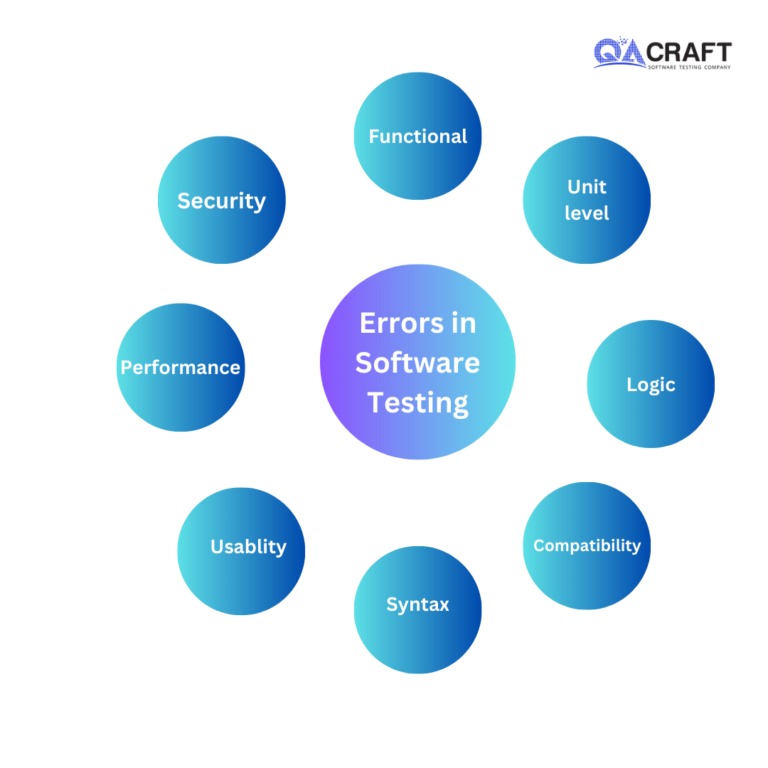30 Mar

What is a software bug?
In software, a bug is an error in the program code that often originates from human error. The most common types of bugs include arithmetic, interface, logic, syntax, and teamwork bugs.
A bug means a software or applications failure or not working as expected results or not working as per requirement.
When a greater number of bugs are in a program, we say it’s buggy, which affects our software or application functionality and causes unexpected results.
Types of Bugs :
There are different types of software bugs:
- Functional Bugs:
- Performance Bugs:
- Security Bugs:
- Unit-level bugs:
- Usability Bugs:
- Syntax Errors:
- Compatibility Errors:
- Logic Bugs:
Functional Bugs:
Functional bugs are related to the functionality of the module of the software. Functional testing is performed to realize the appearance of such defects.
These bugs can manifest themselves in many ways, such as incorrect calculations, incorrect data processing, an incorrect user interface, or incorrect output.
Whenever you perform a functional activity, and the website, app, or software doesn’t react as you expected, it might be a functional issue.
Limited information about our client’s requirements and a lack of knowledge about their product implementations make it difficult to resolve whether a followed behavior is intentional or actually a bug.
Performance Bugs:
Performance bugs are defects that hurdle software performance. This can be related to the speed, stability, response time, and reactivity of the software or application. And these types of bugs are come upon through performance testing.
Performance bugs can have a significant impact on the user experience, causing frustration and impeding productivity. In some cases, performance bugs can even render the software unusable.
To address performance bugs, developers may need to optimize code, use more efficient algorithms, or redesign database schemas. It’s important to conduct performance testing during the development process to identify and address potential performance issues before they become a problem for end-users.
Loading time and response time is more than that required of software or application it’s called a performance bug.
Security Bugs:
A security bug is a flaw or vulnerability in software, hardware, or a system that can be exploited by attackers to compromise the security of the system or gain unauthorized access to sensitive information.
Security bugs can range from simple coding errors to complex design flaws, and they can be introduced at any stage of the development process.
Security bugs include buffer overflows, SQL injection vulnerabilities, cross-site scripting (XSS) vulnerabilities, and improper authentication or authorization mechanisms. Attackers can exploit these bugs to steal sensitive information, take control of systems, or launch attacks on other systems.
To address security bugs, developers must implement secure coding practices, such as input validation, data encryption, and access control mechanisms. Regular security testing and vulnerability scanning can also help identify and address security bugs before they can be exploited by attackers.
Syntax Error:
A syntax bug, also known as a syntax error, is a type of software bug that occurs when there is an error in the programming language syntax of a program.
This means that the code written by the programmer does not follow the rules or grammar of the programming language, making it impossible for the computer to interpret and execute the instructions correctly.
Syntax bugs can occur in any programming language, including Java, Python, C++, and others. syntax errors include missing semicolons, mismatched brackets, misspelled keywords, and incorrect variable declarations.
Syntax bugs can be detected by the compiler or interpreter when the program is being compiled or executed. The compiler or interpreter will identify the line of code where the syntax error occurs and provide an error message indicating the nature of the error.
To fix a syntax bug, the programmer must correct the error in the code, ensuring that it follows the rules and grammar of the programming language. Once the error has been corrected, the program can be recompiled or executed without errors.
It is essential to identify and fix syntax bugs early in the development process, as they can cause the program to crash or produce unexpected results if left unresolved.

Usability Bugs:
Usability bugs are software bugs that impact the user experience of a software system.
Usability bugs can manifest themselves in a variety of ways, such as through confusing or unclear user interface design, non-intuitive workflows, or difficult-to-use features.
These types of bugs can be particularly problematic because they can lead to user frustration, lower productivity, and even abandonment of the software.
Usability bugs can be caused by a variety of factors, such as poor design decisions, preliminary user testing, or insufficient consideration of user feedback.
To address usability bugs, developers can use a variety of techniques, such as user testing, user feedback surveys, and heuristic evaluations. User testing involves having actual users interact with the software to identify areas of difficulty or confusion.
By using these techniques, developers can identify and address usability bugs, improving the overall user experience of the software system. Usability testing should be an ongoing process throughout the development lifecycle, as even small changes can impact the usability of the software.
Unit-level bugs:
Unit-level software bugs are the most common sort of bug you’ll see in every software or application, and they are typically easier to fix. Once the modules of software components are devolved, the developer performs unit-level testing to ensure that the small bundle of code is functioning as expected.
Unit testing involves creating test cases that exercise the code within a unit to verify that it behaves correctly under different conditions. Code reviews involve having other developers review the code to identify potential issues or areas for improvement.
Debugging tools can be used to trace the execution of the code and identify the source of any errors or issues. By using these techniques, developers can identify and fix unit-level bugs before they can cause problems for end-users.
If the developer creates a single-page form, a unit test will verify whether all the input fields are accepting proper inputs and validate button functionality. In cases where an input field doesn’t accept the proper characters or numbers, developers remove a unit-level bug.
Compatibility Errors:
A compatibility bug is a type of software bug that occurs when software behaves differently on different devices or operating systems, causing it to be incompatible with some systems.
Compatibility bugs are often caused by differences in hardware or software configurations, such as different versions of an operating system or incompatible drivers.
Compatibility bugs can be particularly challenging to fix because they often involve multiple systems and configurations. To mitigate the risk of compatibility bugs, software developers often perform extensive testing on different platforms and structures to ensure that their software works as expected across a wide range of systems.
However, it’s impossible to test every possible configuration, and compatibility bugs can still slip through the cracks. When a compatibility bug is discovered, developers must work quickly to identify the root cause and develop a fix that works across all affected systems.
This can involve working closely with hardware and software vendors to identify and resolve compatibility issues.
Logic Bug:
A logic bug is a software bug that occurs when there is an error in the logical flow of a program. This can lead to unexpected or incorrect behavior and can be difficult to detect and fix.
Logic bugs can occur in any type of program, from small scripts to large applications. They can be caused by a variety of factors, such as incorrect assumptions about data or user input, unexpected interactions between different parts of the program, or errors in the implementation of algorithms or data structures.
One common strategy for avoiding logic bugs is to use debugging techniques, such as unit testing, integration testing, and code reviews. Additionally, developers can use formal methods, such as mathematical proofs, to verify the correctness of their programs.
In many cases, logic bugs can be prevented by following best practices for software design and development, such as using clear and consistent naming conventions, separating concerns into modular components, and thoroughly documenting code.
Conclusion:
Deepali works as a Software Development Engineer in Test, at QACraft, she is a computer science engineer with a degree of bachelor and has 3+Years of experience in the software industry as a Manual Tester and Automation Test Engineer. In her free time, she loves reading and podcasts.
Related Post
Leave a Comment Cancel reply
Categories
- Agile Testing
- Alpha Testing
- Android App Testing
- API Testing
- Automation Testing
- Banking Domain Testing
- Beta Testing
- cloud testing
- Corporate Life
- cross browser testing
- Cypress Testing
- desktop testing
- Difference
- Domain Testing
- E-commerce Website Testing
- E-learning App Testing
- End-To-End Testing
- Functional Testing
- Game Testing
- Healthcare Domain Testing
- Integration Testing
- Interview Questions
- ios App Testing
- Jenkins
- JIRA
- Katalon
- Manual Testing
- Mobile App Testing
- Monkey Testing
- Non-Functional testing
- Performance Testing
- Postman
- Regression Testing
- Salesforce Testing
- Sanity Testing
- security testing
- Selenium Testing
- Smoke Testing
- Software Testing
- Stability testing
- Static Testing
- Test Case
- Test Environments
- Test Scenario
- Test Script
- TestRigor
- Web Application Testing
© Copyright 2025 QACraft Pvt. Ltd. All rights reserved.
Contact : +91 9157786796




deepali